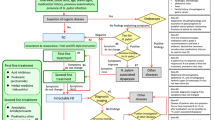Abstract
Esophageal pharmacomanometry (EPM) has become an established procedure for drug evaluation in man. With this method the effect of drugs on smooth muscle in man can be directly investigated. Methods for pressure recording have achieved sufficient accuracy to yield reliable and reproducible results. The procedure is technically easy to perform, is well tolerated, and is safe—so far no serious side effects have been reported. Standard protocols for examination, which have been confirmed by different investigators, have become available. The value of EPM in clinical pharmacology and in clinical medicine can be categorized as follows: Assessment of (1) efficacy of drugs in esophageal motility disorders (prokinetic/spasmolytic compounds); (2) safety of drugs used for other diseases (analysis whether motility is negatively affected, eg, with β2-agonists, calcium antagonists, PGE1 and PGE2 derivatives); (3) differential diagnosis using different drugs in suspected disease; (4) efficacy of anesthesia during operations and of sedation in the critically ill in the intensive care unit (drug monitoring); and (5) pathophysiologic questions using the drug as a tool (eg, metoclopramide in reflux esophagitis). It is important to realize that all drugs used therapeutically in esophageal motility disorders also show an effect in healthy volunteers measurable by esophageal manometry. However, therapeutic studies are ultimately necessary to determine the optimal dose regimen in patients.
Similar content being viewed by others
References
Castell DO, Richter JE, Boag Dalton C: Esophageal Motility Testing. New York, Elsevier, 1987, pp 35–78
Weihrauch TR: Esophageal Manometry. Methods and Clinical Practice. Baltimore, Urban & Schwarzenberg, 1981
Weihrauch TR: Esophageal manometry.In Encyclopedia of Medical Devices and Instrumentation. JG Webster (ed). New York, Wiley & Sons, 1988, pp 1236–1245
Weihrauch TR, Demol P: Pharmacological dose-response curves in gastrointestinal therapy.In Dose-Response Relationships in Clinical Pharmacology. L Lasagna, S Erill, CA Naranjo (eds). Amsterdam, Excerpta Medica, 1989, pp 273–289
Evans Jm, Davies WL, Wise CC: Lower oesophageal contractility: A new monitor of anaesthesia. Lancet 1:1151–1153, 1984
Sinclair ME, Suter PM: A new closed-loop system, based on oesophageal motility, to regulate sedation on the intensive therapy unit. Schweiz Med Wochenschr, 117:459, 1987
Dent J: A new technique for continuous sphincter pressure measurement. Gastroenterology 71:263–267, 1976
Smout AJPM, Bogaard JW, van Hattum J, Akkermans LMA: Effects of cimetidine and ranitidine on interdigestive and postprandial lower esophageal sphincter pressures and plasma gastrin levels in normal subjects. Gastroenterology 88:557–563, 1985
Smout AJPM, Bogaard JW, Grade AC, Ten Thije OJ, Akkermans LMA, Wittebol P: Effects of cisapride, a new gastrointestinal prokinetic substance, on interdigestive and postprandial motor activity of the distal oesophagus in man. Gut 26:246–251, 1985
Bontempo I, Corazziari E, Anzini F, Torsoli A: Effects of oral cisapride administration on distal esophageal motor activity. Gastroenterology 90:1350, 1986
Breedijk M, Smout AJPM, Zouw C, van der, Verwey H, Akkermans LMA: Microcomputer-based system for 24-hour recording of oesophageal motility and pH profile with automated analysis. Med Biol Eng Comput 27:41–46, 1989
Richter JE, Castell DO: 24 hour ambulatory oesophageal motility monitoring: How should motility data be analysed? Gut 30:1040–1047, 1989
Stanciu C, Bennett JR: Metoclopramide in gastrooesophageal reflux. Gut 14:275–279, 1973
Cohen S, Morris DW, Schoen HJ, DiMarino AJ: The effect of oral and intravenous metoclopramide on human lower esophageal sphincter pressure. Gastroenterology 70:484–487, 1976
Weihrauch TR, Förster CF, Krieglstein J: Evaluation of the effect of domperidone on human oesophageal and gastroduodenal motility by intraluminal manometry. Postgrad Med J 55(suppl 1):7–10, 1979
Gilbert RJ, Dodds WJ, Kahrilas PJ, Hogan WJ, Lipman S: Effect of cisapride, a new prokinetic agent, on esophageal motor function. Dig Dis Sci 32:1331–1336, 1987
Baunack AR, Demol P, Froese G, Kuhlmann J, Weihrauch TR: Effect of rioprostil, an oral prostaglandin E1 analogue, on lower oesophageal sphincter pressure and on the motility of the distal oesophagus in healthy volunteers. Scand J Gastroenterol 24:120–126, 1989
Schwartz GF, Levine RA, Sondheimer JM, Petokas S, Gallo-Torres HE, Scheinbaum ML: Effect of trimoprostil, a PGE2 analog, on esophageal motility in man. Gastroenterology 88:1577, 1985 (abstract)
Vantrappen G, Janssens J: Effect of rioprostil on oesophageal motility. Scand J Gastroenterol 24:118–119, 1989
Smart HL, James PD, Atkinson M, Hawkey CJ: Treatment of reflux esophagitis with a prostaglandin analogue. Gut 28:1358–1359, 1987
Weiser HF, Lepsien G, Golenhofen K, Schattenmann G, Siewert R: Klinische und experimentelle Untersuchungen zur Wirkung von Nifedipin auf die glatte Muskulatur des Ösophagus. Z Gastroenterol 15:691–698, 1977
Baunack AR, Demol P, Weihrauch TR: Placebo-controlled comparison of the efficacy of the calcium antagonists Bay 1 8201 and nifedipine on the lower esophageal sphincter pressure (LESP) in volunteers. Gastroenterology 88:1319, 1985
Hongo M, Traube M, mcAllister RG Jr, McCallum RW: Effects of nifedipine on esophageal motor function in humans: Correlation with plasma nifedipine concentration. Gastroenterology 86:8–12, 1984
Richter JE, Dalton CB, Buice RG, Castell DO: Nifedipine: A potent inhibitor of contractions in the body of the human esophagus. Studies in healthy volunteers and patients with the nutcracker esophagus. Gastroenterology 89:549–554, 1985
Swamy N: Esophageal spasm: Clinical and manometric responses to nitroglycerine and long acting nitrates. Gastroenterology 72:23–27, 1977
Weihrauch TR, Förster CF, Waldeck F: Effect of fenoterol on lower esophageal sphincter pressure (LESP) and symptoms in achalasia. Gastroenterology 78:1288, 1980
Konrad-Dalhoff I, Baunack AR, Rämsch K-D, Ahr G, Schmitz H, Weihrauch TR, Kuhlmann J: Efficacy of the calcium antagonists nifedipine, nitrendipine, and nisoldipine on esophageal motility in volunteers. Gastroenterology 96:A267, 1989 (abstract)
Author information
Authors and Affiliations
Rights and permissions
About this article
Cite this article
Weihrauch, T.R., Baunack, A.R. Value of esophageal pharmacomanometry (EPM) for evaluation of drug effects in man. Digest Dis Sci 36, 62S–65S (1991). https://doi.org/10.1007/BF01300598
Received:
Accepted:
Issue Date:
DOI: https://doi.org/10.1007/BF01300598




